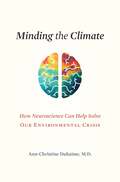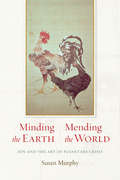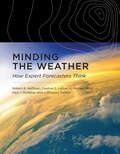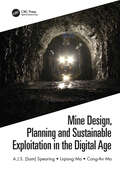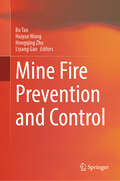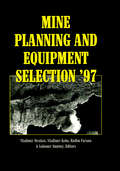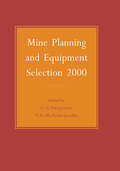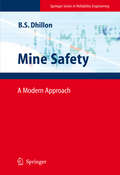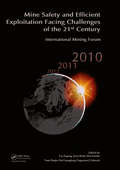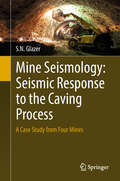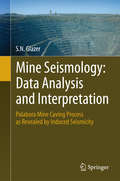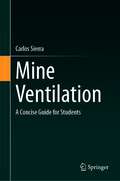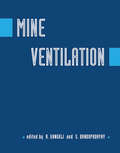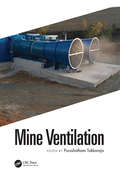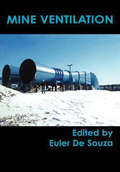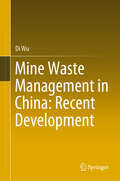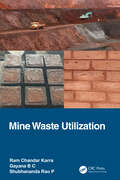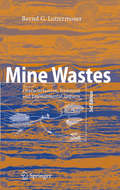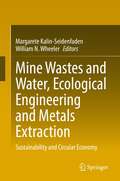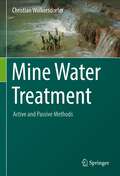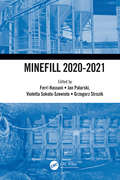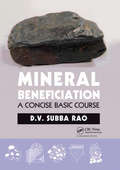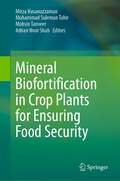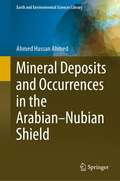- Table View
- List View
Minding the Climate: How Neuroscience Can Help Solve Our Environmental Crisis
by Ann-Christine DuhaimeA neurosurgeon explores how our tendency to prioritize short-term consumer pleasures spurs climate change, but also how the brain’s amazing capacity for flexibility can—and likely will—enable us to prioritize the long-term survival of humanity.Increasingly politicians, activists, media figures, and the public at large agree that climate change is an urgent problem. Yet that sense of urgency rarely translates into serious remedies. If we believe the climate crisis is real, why is it so difficult to change our behavior and our consumer tendencies?Minding the Climate investigates this problem in the neuroscience of decision-making. In particular, Ann-Christine Duhaime, MD, points to the evolution of the human brain during eons of resource scarcity. Understandably, the brain adapted to prioritize short-term survival over more uncertain long-term outcomes. But the resulting behavioral architecture is poorly suited to the present, when scarcity is a lesser concern and slow-moving, novel challenges like environmental issues present the greatest danger. Duhaime details how even our acknowledged best interests are thwarted by the brain’s reward system: if a behavior isn’t perceived as immediately beneficial, we probably won’t do it—never mind that we “know” we should. This is what happens when we lament climate change while indulging the short-term consumer satisfactions that ensure the disaster will continue.Luckily, we can sway our brains, and those of others, to alter our behaviors. Duhaime describes concrete, achievable interventions that have been shown to encourage our neurological circuits to embrace new rewards. Such small, incremental steps that individuals take, whether in their roles as consumers, in the workplace, or in leadership positions, are necessary to mitigate climate change. The more we understand how our tendencies can be overridden by our brain’s capacity to adapt, Duhaime argues, the more likely we are to have a future.
Minding the Earth, Mending the World: Zen and the Art of Planetary Crisis
by Susan MurphyShunryu Suzuki Roshi founded the San Francisco Zen Center in 1962, and after fifty years we have seen a fine group of Zen masters trained in the west take up the mantle and extend the practice of Zen in ways that might have been hard to imagine in those first early years. Susan Murphy, one of Robert Aitken's students and dharma heirs, is one of the finest in this group of young Zen teachers. She is also a fine writer, and following on the teaching of her Roshi she has engaged her spiritual work in the ordinary world, dealing with the practice of daily life and with the struggles of all beings.We know that our earth is in crisis, but is the situation beyond repair? Are we on a path of planetary disaster where the only proper response is to prepare for our melancholic dystopian future? Is there a way out of our suspicious cynicism?In the tradition of Thomas Berry, using this spiritual opportunity to change the very nature of our crisis, Susan Murphy offers a profound message, subtly presented with clarity and assurance, showing that engaged Buddhism provides a possible path to the necessary repair and healing.
Minding the Weather: How Expert Forecasters Think (The\mit Press Ser.)
by H. Michael Mogil Robert R. Hoffman Daphne S. Ladue Paul J. Roebber J. Gregory TraftonA detailed study of research on the psychology of expertise in weather forecasting, drawing on findings in cognitive science, meteorology, and computer science.This book argues that the human cognition system is the least understood, yet probably most important, component of forecasting accuracy. Minding the Weather investigates how people acquire massive and highly organized knowledge and develop the reasoning skills and strategies that enable them to achieve the highest levels of performance.The authors consider such topics as the forecasting workplace; atmospheric scientists' descriptions of their reasoning strategies; the nature of expertise; forecaster knowledge, perceptual skills, and reasoning; and expert systems designed to imitate forecaster reasoning. Drawing on research in cognitive science, meteorology, and computer science, the authors argue that forecasting involves an interdependence of humans and technologies. Human expertise will always be necessary.
Mine Design, Planning and Sustainable Exploitation in the Digital Age
by A.J.S. (Sam) Spearing Liqiang Ma Cong-An MaMine Design, Planning and Sustainable Exploitation in the Digital Age covers mine planning, design and exploitation taking cognizance of new developments, especially those associated with the Fourth Industrial Revolution and the positive influence that it has, and will have, on the mining industry. It refers to latest best practices with emphasis on the social license to operate and sustainable (green) mining. The book covers surface and underground mining in some detail and addresses relevant associated aspects such as risk management, green mining and the importance of real community relations. It is organized as follows: Surface Mining Underground Soft Rock Mining Underground Hard Rock (Metal/Non-metal) Mining Green and Sustainable Mining It has many relevant photos and figures that help the reader and includes appropriate support design and types commonly used in the various mining methods. Mine Design, Planning and Sustainable Exploitation in the Digital Age is mainly aimed at mining, geological engineering and other undergraduate and postgraduates interested in the mining resources industry. It will also serve as a useful reference book for practitioners in the mining industry who want an easy-to-use book.
Mine Fire Prevention and Control
by Haiyan Wang Bo Tan Hongqing Zhu Liyang GaoThis book belongs to the field of mine safety, and it first introduces the severity of mine fire and the impact of mine fire on air flow through practical cases, and then leads to the most important control technology of underground air flow during fire. At the same time, the causes of mine fire, the characteristics of fire and the commonly used equipment for fire fighting are systematically sorted out and analyzed. The corresponding monitoring and prevention measures are given for different places and different types of mine fires. The theoretical analysis of this book is of great significance for the continuous improvement and strengthening of coal mine fire prevention and control technical measures, and ensures the personal safety and normal production of coal mine personnel. The feature is from the actual accident lessons, from the tragic accident safety analysis. For readers, you can learn about the accident in this special scenario, understand the basic theory of preventing and extinguishing mine fires, and give reference to the safety production of other industries. The main readers are safety management personnel, coal mine practitioners and mining field students.
Mine Planning and Equipment Selection 1997
by Vladimír StrakošPresenting current and emerging technologies in the field of mine planning and equipment, this volume also covers control and automation for surface and underground mining. A wide range of papers from professionals in Europe, South America, Africa and Australia are featured.
Mine Planning and Equipment Selection 2000
by G. N. Panagiotou T. N. MichalakopoulosThis text looks at mine planning and equipment and covers topics such as: design and planning of surface and underground mines; geotechnical stability in surface and underground mines; and mining and the environment.
Mine Safety
by Balbir S. DhillonMine Safety combines detailed information on safety in mining with methods and mathematics that can be used to preserve human life. By compiling various recent research results and data into one volume, Mine Safety eliminates the need to consult many diverse sources in order to obtain vital information. Chapters cover a broad range of topics, including: human factors and error in mine safety, mining equipment safety, safety in offshore industry and programmable electronic mining system safety. They are written in such a manner that the reader requires no previous knowledge to understand their contents. Examples and solutions are given at appropriate places, and there are numerous problems to test the reader's comprehension. Mine Safety will prove useful for many individuals, including engineering and safety professionals working in the mining industry, researchers, instructors, and undergraduate and graduate students in the field of mining engineering.
Mine Safety Science and Engineering: Health and Disaster Management
by Debi Prasad TripathyIn Mining Engineering operations, mines act as sources of constant danger and risk to the miners and may result in disasters unless mining is done with safety legislations and practices in place. Mine safety engineers promote and enforce mine safety and health by complying with the established safety standards, policies, guidelines and regulations. These innovative and practical methods for ensuring safe mining operations are discussed in this book including technological advancements in the field. It will prove useful as reference for engineering and safety professionals working in the mining industry, regulators, researchers, and students in the field of mining engineering.
Mine Safety and Efficient Exploitation Facing Challenges of the 21st Century: International Mining Forum 2010
by Jerzy Kicki Eugeniusz J. Sobczyk Liu Zegong Hua Xinzhu Yuan Shujie Dai GuanglongThe International Mining Forum is a meeting of scientists and professionals for exchanging new ideas and experiences, evaluate previously implemented solutions, and discuss fresh ideas that might change the mining industry's image. In recent years theory and technology in mine safety and efficient exploitation has made considerable progress in Chin
Mine Seismology: A Case Study from Four Mines
by S. N. GlazerThis book presents the results of seismic data analysis and interpretation based on nearly one million seismic events. This seismicity was induced by the caving process in four copper mines, each located on a different continent. The book not only serves as an interpretation guide, it also illustrates the benefits of evaluating data from different mines:How to establish which seismic data base is faulty and whyThe formation of a universal seismic response to the caving processIndisputable evidence that hydro-fracturing improves underground safety This book invites discussion on more general aspects of research, such as:Basic research, applied research and implementationPredicting mine-induced seismic eventsQuantitative versus qualitative seismologyResearch versus pseudo-researchWhat is genuine research?[In the Parlabora Mine] Stefan has demonstrated that [the] use of the seismic system was a very practical means of monitoring the progression of the cave up to and beyond break through into the open pit above. The seismic system was vital in drawing up the undercutting and seismic protocols and determining the maximum potential seismic hazard level. Peter Townsend Retired Mine Manager and ConsultantI consider Stefan the pioneer of using microseismic data to provide understanding of the mechanism and progress of cave mining. Science has advanced considerably since the use of less than reliable extensometers to monitor the cave back position and Stefan was leading this advance. (…)This book provides a lot of useful insight[s] in how we can best understand the data that we (…) gather and how to change this data into useful information. Neil Hepworth C. Eng, MIMMM, Geomin Consultorio – Brazil. Consultant Mining and GeotechnicsStefan mine seismology trilogy is (…) a comprehensive tutoring on how to analyse and interpret mine induced seismicity. This coaching is based on multiple practical examples (…) presented from the problem to be solved [with] input data tests followed by analysis and interpretation. This last is presented with many details that explain the whole process. Mahdi Bayuargo, ST, MAScPT. Duaem Gada Bayuagus Managing Director
Mine Seismology: Data Analysis and Interpretation
by S. N. GlazerThis book offers an in-depth analysis and interpretation methods applicable to mine-induced seismicity. It is based on over 40 years of experience in mine and exploration geophysics. Another unique feature of this book is the complete history of the caving process as evidenced by the recorded seismicity at the South African copper mine Palabora Lift 1. Until now, the literature has only presented theory and case studies discussing the interpretation of results, and there has been no discussion of the input-data quality or why a certain interpretation technique was applied. This book fills that gap. This book is a fascinating read, written by one of the world's leading mine seismologists. It summarises the history and progression of mine seismology. It outlines the practical use of back analysis of data and how it can be used on a daily basis. The book explains how mine seismology can be used as an effective monitoring tool for key events as the mine progresses as well as for future caving operations. Anthony Allman MAusIMM, CP(Min), RPEQ Antcia Consulting Pty Ltd, Director, Mining Engineer The content of the book is really solid and robust and I have no doubt it is going to be considered a great contribution for the mining community. Raul Fuentes, Former Director of Master Program in Geomechanics Applied to Mining, Universidad de los Andes, Santiago, Chile This book is long overdue and helps to present some difficult concepts in a way that they can be clearly understood by non-experts in this area. Stefan has personally managed to take mine seismology from being a black-art into a useful tool to help make mines a safer and more controlled environment. Neil Hepworth C. Eng, MIMMM, Geomin Consultorio - Brazil, Consultant Mining and Geotechnics Seismic monitoring is an important tool in cave management. The information from monitoring allows a number of key production factors to be determined including cave advance rates, the approximate location of the cave back, insight into the size of the air gap and allows the tracking of broad changes in stress. These all assist in the day to day management of a safe and successful cave. Dr. Glazer's book provides guidance on the application of microseismicity to cave management through a review of appropriate theory and more importantly illustrates its use through case histories, particularly from the Palabora block cave. The text will be a good addition for all practitioners in cave engineering and operations. Allan Moss, General Manager - Grasberg Underground Liaison, Copper Development, Rio Tinto
Mine Ventilation: A Concise Guide for Students
by Carlos SierraThis textbook focuses on underground ventilation, addressing both theoretical and practical aspects. Readers will develop a deeper understanding of mine ventilation and adjacent areas of research. The content is clearly structured, moving through chapters in a pedagogical way. It begins by presenting an introduction to fluid mechanics, before discussing the environmental conditions in mines, underground fire management, and international legislation concerning mines. Particular attention is paid to development ends ventilation, an area that is underrepresented in scientific research. Each chapter includes a concise theoretical summary, followed by several worked-out examples, problems and questions to develop students’ skills.This textbook will be useful for undergraduate and master’s degree students around the world. In addition, the large number of practical cases included make it particularly well suited to preparing for professional engineer examinations and as a guide for practising engineers.
Mine Ventilation: Proceedings of the 10th US / North American Mine Ventilation Symposium, Anchorage, Alaska, USA, 16-19 May 2004
by R. Ganguli S. BandopadhyayThe purpose of the 10th US North American Mine Ventilation Symposium in Anchorage 2004 was to bring together practitioners involved in the planning and operation of underground ventilation systems, to provide a forum for debate and exchange of ideas, and to share information on the advances which have been made and consider problems
Mine Ventilation: Proceedings of the 18th North American Mine Ventilation Symposium, 12-17 June, 2021, Rapid City, South Dakota, USA
by Purushotham TukkarajaThis volume contains the proceedings of the 18th North American Mine Ventilation Symposium held, on a virtual platform, June 12-17, 2021. This symposium was organized by South Dakota Mines, Rapid City, South Dakota, in collaboration with the Underground Ventilation Committee (UVC) of the Society for Mining, Metallurgy & Exploration (SME). The Mine Ventilation Symposium series has always been a premier forum for ventilation experts, practitioners, educators, students, regulators, and manufacturers from around the world to exchange knowledge, ideas, and opinions. This volume features fifty-seven selected technical papers in a wide range of topics including: auxiliary ventilation, case studies of mine ventilation, computational fluid dynamics applications in mine ventilation, diesel particulate control, electric machinery in mine ventilation, mine cooling and refrigeration, mine dust monitoring and control, mine fans, mine fires and explosion prevention, mine gases, mine heat, mine management and organization of ventilation, mine ventilation and automation, occupational health and safety in mine ventilation, renewable/alternative energy in mine ventilation, ventilation monitoring and measurement, ventilation network analysis and optimization, and ventilation planning and design.
Mine Ventilation: Proceedings of the North American/Ninth US Mine Ventilation Symposium, Kingston, Canada, 8-12 June 2002
by Euler De SouzaThis proceedings volume showcases all aspects of the science and engineering of mine ventilation and health and safety, with special focus on the applied aspects of mine ventilation practice. Papers span the spectrum of mine ventilation and air conditioning.
Mine Waste Management in China: Recent Development
by Di WuThis book introduces recent development of technologies for mine waste management in China. For hard rock mines, the main mine wastes are tailings, and the tailings can be disposed above-ground and/or underground. The technology of consolidated tailings stockpile (CTS) that disposes tailings above-ground is introduced, and the application of this technology is also demonstrated. Besides, the technology of cemented tailings (or paste) backfill (CTB or CPB) which deals with tailings underground is also discussed. The properties of CTB materials and the utilization of CTB technology are described and analyzed. For coal mines, the main mine wastes are coal gangue and fly ash. The technology of cemented coal gangue-fly ash backfill (CGFB) that manages coal mine waste underground is presented. The THMC coupling properties of CGFB materials are investigated, which can contribute to a better design of stable, durable and environmentally friendly CGFB mixtures. The application of CGFB technology in a coal mine is also presented. This book, which systematically reviews and discusses the development of mine waste management technologies in China, is expected to provide readers comprehensive information about mine waste management.
Mine Waste Utilization
by Ram Chandar Karra Gayana B. C. Shubhananda Rao P.This book is a comprehensive work on utilization of overburden waste, ash, tailings, and other processed waste produced by mining industry. It details various laboratory tests to identify the suitability of mine waste. It explains varied usage of different types of mine waste as in concrete pavements, bricks and to enhance fertile characteristics of waste lands. Various physico-mechanical properties of mine waste material and their optimum percentage for replacement with sand and coarse aggregate along with additives for optimum strength of concrete / bricks are discussed. Key features: Covers the technical approach in terms of testing and characterizing mine waste Focusses on effective use of mining waste to make sustainable and ecofriendly mining Presents analysis of physical properties of iron ore waste and their usage Describes testing methods for each type of mine waste and its physical property characterization for every application Includes detailed study to use iron ore waste and tailings in concrete pavements This book is aimed at researchers, professionals and graduate students in mining, geotechnical, and civil engineering.
Mine Wastes
by Bernd LottermoserThis book provides a thorough, up-to-date overview of wastes accumulating at mine sites. It deals comprehensively with sulfidic mine wastes, mine water, tailings, cyanidation wastes of gold-silver ores, radioactive wastes of uranium ores, and wastes of phosphate and potash ores. The book emphasizes the characterization, prediction, monitoring, disposal and treatment as well as environmental impacts of problematic mine wastes. The strong pedagogical framework is supported by case studies from around the world, presentation of crucial aspects of mine wastes as scientific issues; end-of-chapter summaries as well as lists of resource materials and www sites for each waste type. The considerably updated third edition has novel and notable changes including: revision of text to reflect major developments and contemporary issues that are taking place in the field of mine waste science; new web pages at the end of each chapter; over 20 case studies and scientific issues; over 150 figures and tables; and an updated bibliography with over 1200 references. This newly balanced text will continue to equip the student and the professional with a thorough understanding of the principles and processes of mine wastes.
Mine Wastes and Water, Ecological Engineering and Metals Extraction: Sustainability and Circular Economy
by Margarete Kalin-Seidenfaden William N. WheelerThe book reviews past and present mine waste management processes. It estimates global water consumption by major mining resources per annum. This consumption will lead land use resources (agriculture and water) to collide with mining interests expected in the near future. With the application of novel metal extraction processes and the adoption of ecological engineering as an approach to waste and water management, a reduction in water and land consumption can be achieved. Using these methodologies would make mining more sustainable. Together with ore and metal recycling, mining methods can be brought into the 21st century. The book describes natural weathering processes and the microbiology of extreme environments, also known as mine sites. The role of microbes in weathering and remediation is emphasized, along with case studies of the enhancement of various ecological processes which curtail weathering and transform pollutants, creating ore bodies of the future.This book has been written as an extension to a contribution to the Oxford Research Encyclopedia. It adds depth and many examples from 40 years of multidisciplinary work with experts from geology, hydrogeology, geomicrobiology and algal physiology and chemistry, items too extensive for the Encyclopedia.
Mine Water Treatment – Active and Passive Methods
by Christian WolkersdorferThis book accompanies you on a journey that starts with the basics of mine water and takes you further through correct sampling for planning to active and passive purification systems. In the respective chapters you will learn the most important techniques about the parameters to be measured (e.g. on-site parameters, flow rate), which methods are available to actively purify your mine water (e.g. thick sludge method, reverse osmosis, ion exchange) and which ones to perform passive purification (e.g. constructed wetlands, vertical flow reactor, carbonate channel). You will also get an insight into the use of mine water. Don't expect a cookbook - rather, it's an ingredients and utensils list to help you find the right recipe. For extended help on this, check out the nearly 1000 references on all the techniques presented. I wrote this book for hydrogeologists, engineers, graduate students, government officials, miners, geoecologists, chemical engineers - in the broadest sense, you.
Minefill 2020-2021: Proceedings of the 13th International Symposium on Mining with Backfill, 25-28 May 2021, Katowice, Poland
by Ferri HassaniThe series of International Symposiums on Mining with Backfill explores both the theoretical and practical aspects of the application of mine fill, with many case studies from both underground and open-pit mines. Minefill attendees and the Proceedings book audience include mining practitioners, engineering students, operating and regulatory professionals, consultants, academics, researchers, and interested individuals and groups.The papers presented at Minefill symposiums regularly offer the novelties and most modern technical solutions in technology, equipment, and research. In that way, the papers submitted for the Minefill Symposia represent the highest quality and level in the conference domain. For the 2020-2021 edition organizers hope that the papers presented in this publication will also be received with interest by readers around the world, providing inspiration and valuable examples for industry and R&D research.
Mineral Beneficiation: A Concise Basic Course
by D.V. Subba RaoMineral Beneficiation or ore dressing of run-of-mine ore is an upgrading process to achieve uniform quality, size and maximum tenor ore through the removal of less valuable material. Beneficiation benefits the costs of freight, handling, and extraction (smelting) reduce, and the loss of metal through slag. Usually carried out at the mine site, it s
Mineral Biofortification in Crop Plants for Ensuring Food Security
by Mirza Hasanuzzaman Mohsin Tanveer Muhammad Suleman Tahir Adnan Noor ShahThis book provides a comprehensive summary of the recent advances in the biofortification of plants under climate change and how it affects food security globally. The need for mineral biofortification to eradicate or alleviate malnutrition through sustainable agriculture is also discussed. Biofortification of edible plants is considered the most appropriate approach to alleviate nutritional problems and nutrient deficiencies. In contrast, biofortification focuses on improving the nutritional content of the region's current agricultural biodiversity while preserving its habits and customs. Emphasis is also placed on recent advances and developments in omics, particularly metabolomics and related techniques, to unravel the potential alterations in plants caused by biofortification. The book brings together eminent scientists to present the latest developments in the field. This timely publication addresses practical scenarios of bio-fortified food production and climate change. The book focuses on the methods, techniques, and environmental changes used to enhance and improve agricultural products. This book is one of the first to provide information on the use of modern biotechnologies to modify crops for health benefits. It also examines the mechanisms of the plant responses to genetically induced biofortification, the production and responses of fortified plants under climate change, and their effects on food security. The book will be useful for students and researchers, especially crop scientists, environmental scientists, biotechnologists, botanists, and agronomists, to understand the techniques and mechanisms of biofortification, and responses of biofortified plants under climate change.
Mineral Deposits and Occurrences in the Arabian–Nubian Shield (Earth and Environmental Sciences Library)
by Ahmed Hassan AhmedThis book presents a detailed review of the mineral deposits and occurrences in the Arabian-Nubian Shield (ANS), including their distribution, mineralization styles, economic importance, and geological controls on the mineralization. The purpose of the book is to compile the results of past and recent investigations on mineral deposits and occurrences in the ANS that covering the countries of (Saudi Arabia, Yemen, Egypt, Sudan, Eritrea, and Ethiopia). In this regard, it discusses in detail the various genetic mineralization styles in the ANS including: (1) magmatic mineral deposits associated with mafic-ultramafic rocks (e.g. chromite, Ni-Cu-Co-PGE magmatic sulfides, Fe-Ti-V oxides), (2) intrusion-related (magmatic-hydrothermal) deposits associated with felsic to intermediate rocks (porphyry, epithermal Au-Ag/sulfide vein type family, skarn, granite-related pegmatite-REE deposits), (3) hydrothermal orogenic gold and volcanogenic massive sulfide (VMS) deposits, as well as (4) surficial mineral deposits (chemical-sedimentary, residual, mechanical and supergene enrichment deposits).
